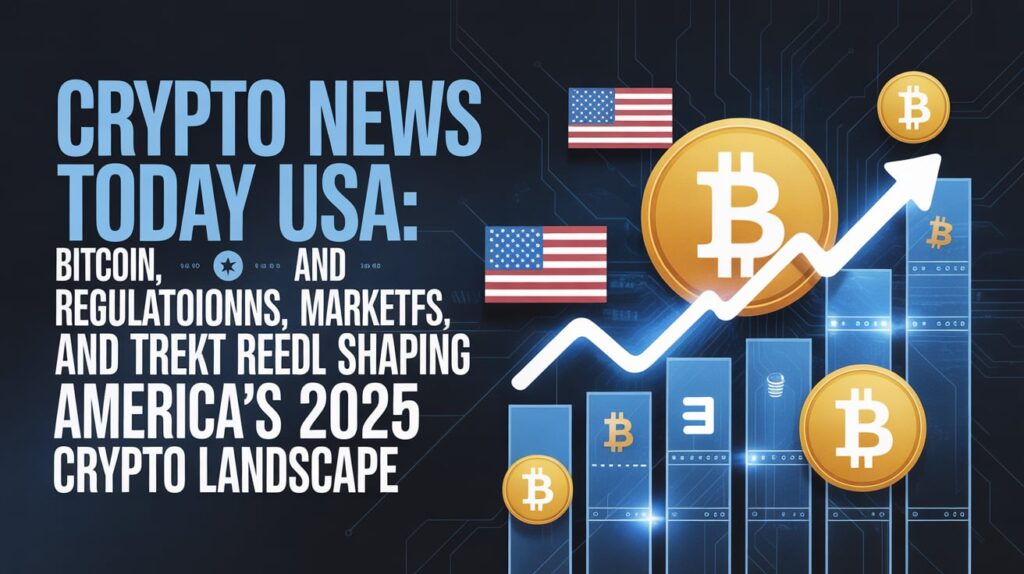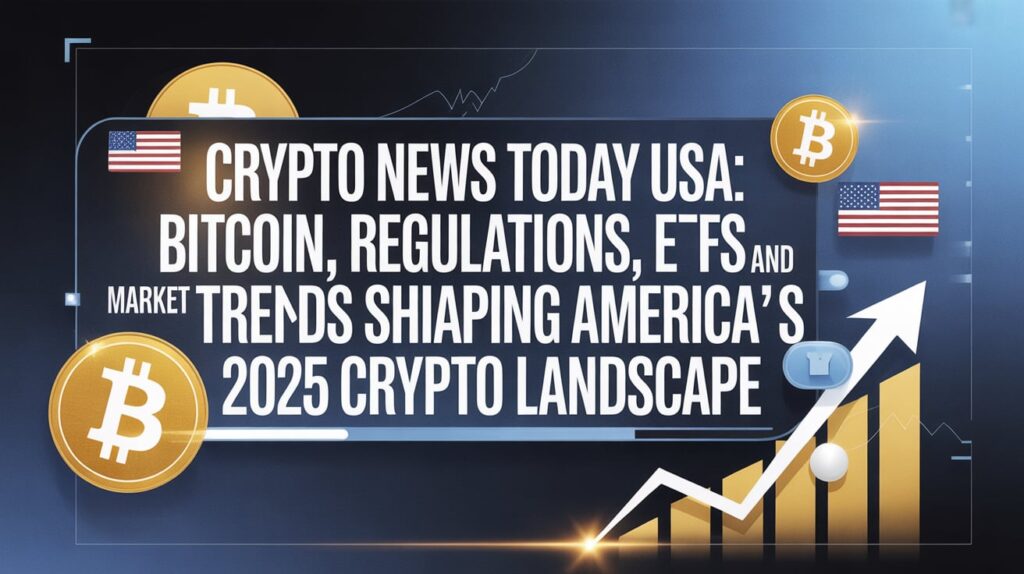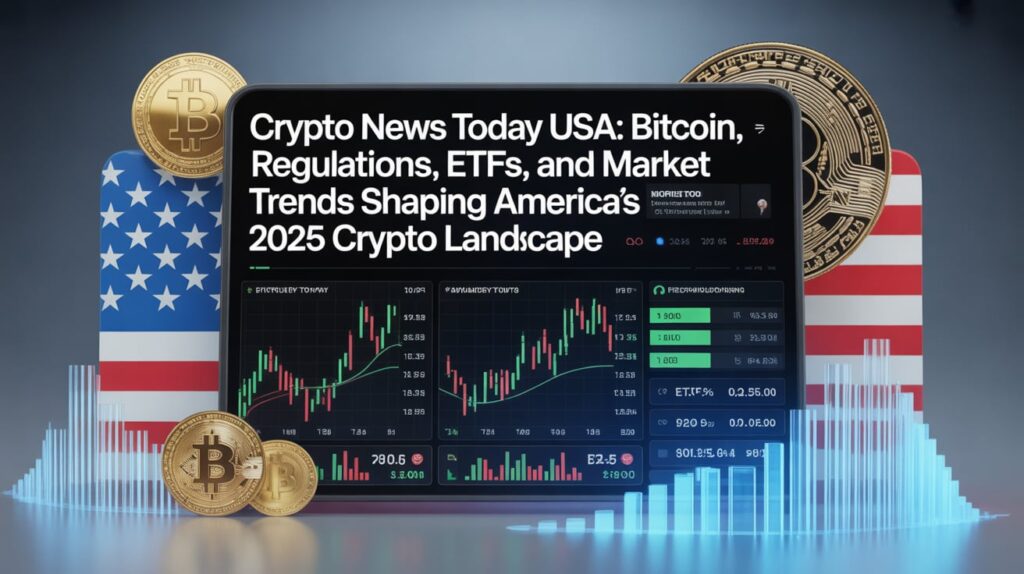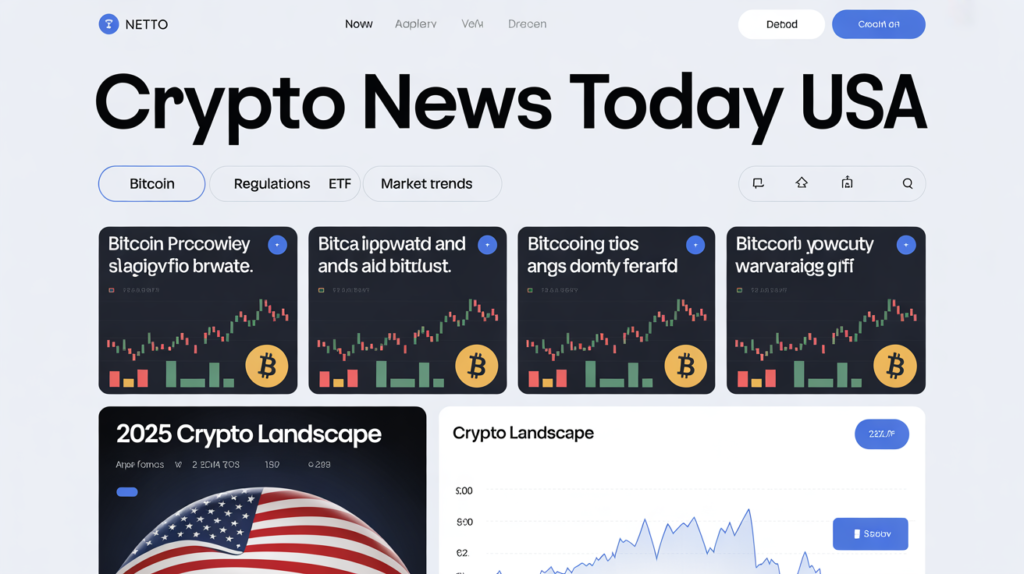Crypto News Today USA: Bitcoin, Regulations, ETFs, and Market Trends Shaping America’s 2025 Crypto Landscape

Introduction: The Pulse of America’s Crypto Market
Every day, the crypto news in the USA reads like a high-stakes drama — packed with breakthroughs, regulations, billion-dollar deals, and unexpected twists. From Bitcoin’s price swings to Wall Street’s crypto ETFs, to Washington D.C.’s evolving digital-asset laws, the American crypto scene has become the heartbeat of the global blockchain industry.
As of late 2025, the U.S. cryptocurrency market is stronger, more regulated, and more mainstream than ever before. The once-volatile industry is maturing fast, drawing interest from institutions, hedge funds, tech giants, and even the federal government.
But behind the headlines, a deeper story is unfolding — one about innovation, policy battles, market psychology, and America’s quest to lead the digital asset revolution.
This comprehensive article explores the biggest crypto news in the USA today — trends, developments, opportunities, and risks — to help readers understand where the market is heading next.
Chapter 1: The State of Crypto in America 2025
1.1 From Skepticism to Adoption
Five years ago, U.S. regulators viewed crypto as a speculative fad. Today, it’s a regulated asset class integrated into the country’s financial DNA. Bitcoin ETFs trade daily on NASDAQ. Banks like JPMorgan and Goldman Sachs have digital-asset desks. Even BlackRock’s iShares Bitcoin Trust has surpassed $60 billion in assets.
This shift reflects one clear message: crypto is no longer niche — it’s institutional.
1.2 The Numbers Behind the Growth
-
U.S. market share: Over 48% of global crypto liquidity flows through American platforms.
-
Active wallets: More than 64 million verified crypto accounts across U.S. exchanges.
-
Corporate exposure: Roughly 18% of Fortune 500 companies** hold or use blockchain assets.
-
ETFs: More than 12 Bitcoin and Ethereum ETFs now trade across U.S. markets.
The result? The United States isn’t just following the crypto trend — it’s defining it.
Chapter 2: The Biggest Crypto News Headlines in the USA Today
2.1 Bitcoin Hits Record High Amid ETF Inflows
The biggest headline across major U.S. outlets this week: Bitcoin (BTC) surged past $126,000, fueled by record ETF inflows. Institutional investors continue to pour capital into spot Bitcoin ETFs, with BlackRock, Fidelity, and ARK leading the charge.
Analysts attribute the rally to:
-
Lower inflation data, boosting investor appetite for risk assets.
-
Regulatory clarity from the SEC, easing fears of crackdowns.
-
Strong demand from U.S. pension and hedge funds.
This institutional confidence has made the U.S. the largest source of Bitcoin investment inflows globally.
2.2 Ethereum’s Comeback: Layer 2s and Real-World Assets

Ethereum is back in the spotlight after a 2025 network upgrade slashed gas fees by 80%. American developers are driving the Layer-2 boom through networks like Base (by Coinbase), Arbitrum, and Optimism, making decentralized apps faster and cheaper.
Even more exciting is Ethereum’s dominance in Real-World Asset (RWA) tokenization.
U.S. firms like Franklin Templeton and J.P. Morgan Onyx are using Ethereum to tokenize treasury bills, real estate, and corporate bonds — creating a trillion-dollar new investment sector.
2.3 Stablecoins: The Dollar’s Digital Twin
Stablecoins — the digital versions of the U.S. dollar — are reshaping payments across the country.
In 2025, U.S. stablecoins like USDC (Circle) and PYUSD (PayPal) handle over $400 billion in monthly transactions.
The U.S. Congress recently passed the Digital Dollar and Stablecoin Oversight Act, officially recognizing stablecoins as part of the regulated financial system.
This move has triggered:
-
Wider adoption by U.S. fintechs and banks
-
Enhanced consumer protections
-
Greater confidence among institutional players
Stablecoins are now the bridge between traditional finance (TradFi) and decentralized finance (DeFi).
2.4 Regulatory Clarity: SEC and CFTC Finally Align
For years, the biggest question in the U.S. crypto space was: Who regulates what?
Now, in 2025, the SEC and CFTC have finally coordinated on a clear jurisdictional framework.
Key takeaways from the new 2025 guidance:
-
Bitcoin and Ethereum are officially commodities, not securities.
-
Utility tokens and NFTs fall under consumer protection laws, not securities laws.
-
DeFi protocols must follow smart-contract auditing standards and KYC compliance for institutional users.
This alignment has boosted investor trust and reduced market uncertainty.
2.5 Presidential Policy and Political Impact
Crypto is now political. With the 2024 U.S. elections concluded, both major parties acknowledge the need for blockchain innovation.
The current administration’s “Digital Asset Competitiveness Agenda” includes:
-
National blockchain R&D programs
-
Federal crypto-tax guidelines
-
Integration of blockchain in public procurement
-
Encouragement for U.S. companies to lead in Web3 innovation
Crypto policy has officially gone mainstream — a dramatic shift from 2020’s skepticism.
Chapter 3: Market Trends Dominating the U.S. Crypto Scene
3.1 Tokenization of Everything
From real estate to fine art to carbon credits, tokenization is the hottest trend in the U.S. market. By 2025, over $600 billion in real-world assets have been tokenized on public and permissioned blockchains.
U.S. banks, funds, and tech startups are rushing to create blockchain-based marketplaces for traditional assets — a sign that crypto is becoming a bridge to real-world value, not a speculative bubble.
3.2 DeFi Meets TradFi

“DeFi 2.0” has arrived in America. Platforms like Aave, Compound, and Maple Finance are now partnering with regulated U.S. banks to provide institutional liquidity.
American regulators are introducing DeFi compliance frameworks — allowing banks to lend and borrow through smart contracts with transparency and safety.
This merger of DeFi and TradFi could unleash hundreds of billions in new on-chain liquidity.
3.3 NFTs and the Entertainment Industry
NFTs are no longer just digital art — they’re now digital rights.
Hollywood studios, record labels, and sports franchises are using NFTs for ticketing, licensing, and fan engagement.
Platforms like Warner Music Web3, Disney Metaverse Studios, and NFL All Access are redefining digital ownership, showing that the USA is still the global hub for creative blockchain adoption.
Chapter 4: The Role of U.S. Exchanges and Institutions
4.1 Coinbase: America’s Digital Asset Giant
Coinbase, headquartered in California, remains the cornerstone of U.S. crypto adoption. Its expansion into Coinbase Base Network (L2) and ETF partnerships have solidified its reputation as America’s first crypto “blue chip.”
4.2 NASDAQ & Wall Street’s Web3 Shift
Traditional giants like NASDAQ and BlackRock have fully embraced blockchain. NASDAQ recently launched a tokenized securities trading platform, while BlackRock’s tokenization initiative now handles over $10 billion in tokenized U.S. Treasuries.
This hybrid model of finance — where blockchain underpins real-world assets — is redefining investment norms.
Chapter 5: The Challenges Ahead

5.1 Security & Hacking Risks
Even in 2025, crypto hacking remains a threat. The U.S. FBI’s Cyber Unit reports that phishing and DeFi exploits accounted for $2.4 billion in losses this year.
However, newer wallet tech and AI-driven fraud detection are cutting these losses significantly.
5.2 Energy & Sustainability
While Bitcoin mining in the U.S. has gone greener, critics still question its environmental cost.
Thankfully, over 60% of U.S. mining operations now use renewable energy, driven by states like Texas and Wyoming.
5.3 Education & Accessibility
With over 70 million U.S. adults owning crypto, education is key. Initiatives like CryptoLiteracy.org and government-backed digital finance programs aim to make blockchain literacy mainstream by 2030.
Chapter 6: The Future Outlook — What’s Next for Crypto in the USA
6.1 Spot Ethereum ETF & Institutional Expansion
The next big wave? Ethereum ETFs. With SEC approval expected soon, analysts project another $50 billion in inflows, mirroring Bitcoin’s 2024 ETF success.
6.2 CBDCs and Digital Dollar
The Federal Reserve’s Digital Dollar pilot enters phase three, testing blockchain-based payment rails in several states. This move could redefine cross-border payments, with stablecoins coexisting alongside a U.S. central bank digital currency (CBDC).
6.3 AI, Metaverse, and Blockchain Integration
AI-powered trading bots, blockchain-based data ownership, and immersive metaverse economies are merging into a unified ecosystem. The USA is spearheading this transformation through both startups and legacy tech firms.
Chapter 7: Key Takeaways for Investors and Enthusiasts
-
Stay updated daily. U.S. crypto markets move faster than ever.
-
Regulatory clarity = opportunity. 2025 marks the safest environment yet for compliant crypto investing.
-
Diversify exposure. Beyond Bitcoin and Ethereum, explore RWAs, DeFi, and AI-integrated tokens.
-
Use trusted platforms. Stick with U.S.-regulated exchanges and custodians.
-
Adopt long-term thinking. The 2025 market is about sustainable growth — not short-term hype.
Conclusion: The U.S. Crypto Story Has Just Begun
The crypto news in the USA today isn’t just about prices — it’s about policy, innovation, and global leadership. America stands at the center of a new digital economy, where finance meets code, and opportunity meets responsibility.
From Wall Street to Silicon Valley, from federal policymakers to grassroots developers, the United States is setting the tone for crypto’s next decade.
For investors, entrepreneurs, and dreamers alike, one truth stands tall:
The future of crypto will be written — and regulated — in the USA.